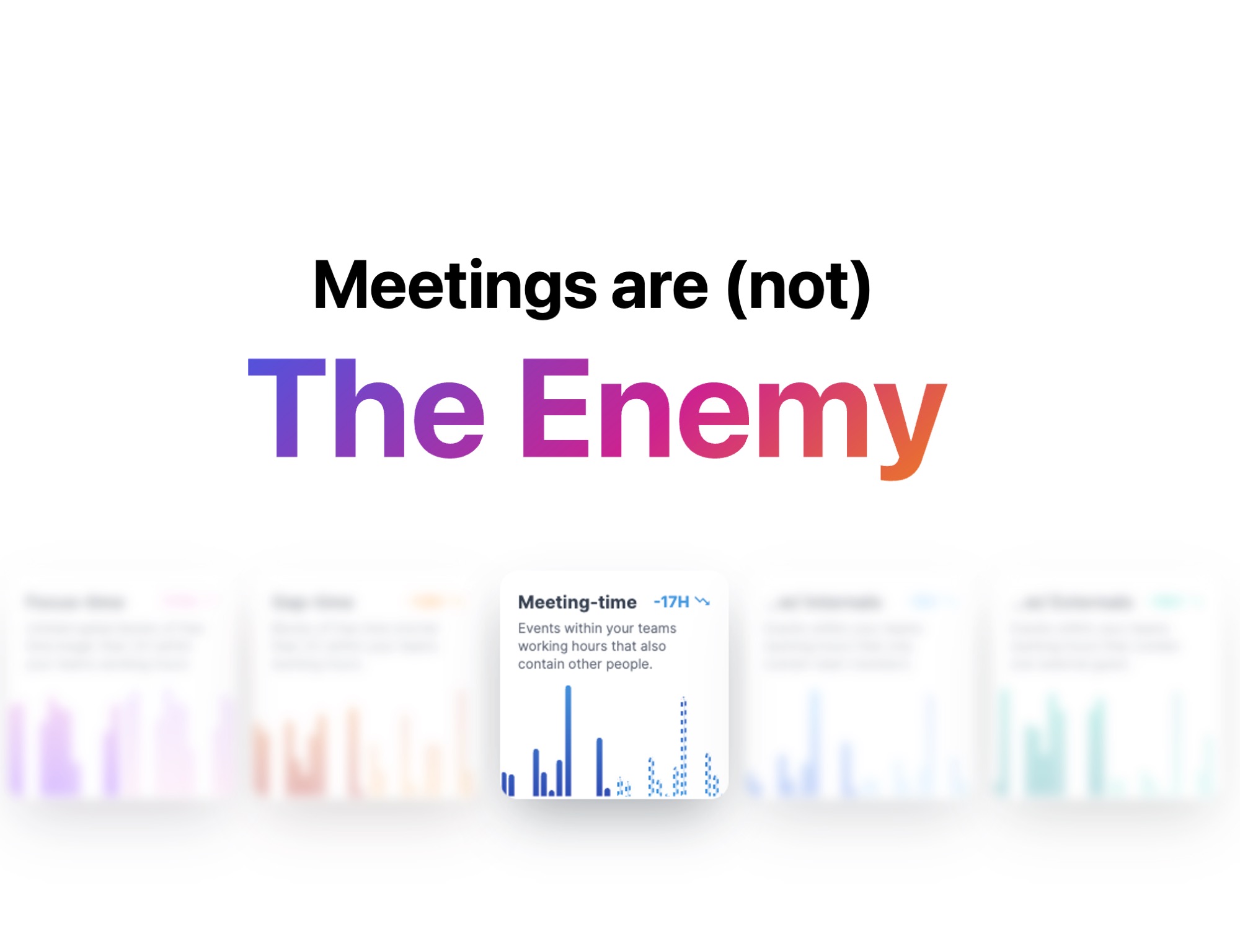Meetings Are Not The Enemy: Guide To Making Them Work For You
8 min readDo we hate meetings or just bad meetings? A case on directing blame to the wrong place.

Earlier this year Shopify made headlines with their move to cancel all recurring meetings. Many people applauded the move. People rallied behind what seems to have become a common enemy….the meeting.
But is it really meetings that we hate or is it bad meetings? Feels like a case where we are directing blame to the wrong place.
Why we meet
How to set meeting standards
How to set up a good meeting cadence
How to evaluate your meetings
How to create help your team manage meeting time
Why we meet
There is plenty written about meetings. Essentially I think it boils down to 4 reasons – to connect, to align, to debate and to decide.
I lead with to connect because humans are social creatures. We crave connection and to be understood. While I am a big fan of asynchronous work and love the advancements made in collaboration tools accelerated by the pandemic, I still think we need synchronous communication to build connections.
Alignment is crucial for productivity in any organization. When team members are aligned and have a clear understanding of the goals, priorities, and expectations they work more efficiently and effectively. No more time wasted on tasks that aren’t important or getting stuck on misaligned ideas. Meetings are an excellent way to achieve alignment. Taking the time to align and clarify, avoids so many problems. Ultimately, alignment helps a team do their best work and meetings are an essential tool for achieving this.
When coming together around a decision to be made it is important to be clear about whether the purpose of that meeting is to debate or decide. Are you in the process of collecting more data or points of view? Do you need to take action right away? You will save yourself a lot of frustration by stating upfront what the goal is and having everyone in the right mindset. Trying to wrangle a decision from people geared up for a debate is an exercise in frustration.
We meet for lots of reasons. To get the most out of your time and your team, be clear about your purpose.
Why Set Meeting Standards
In spite of their bad press, meetings are an essential aspect of any company’s operations. They enable teams to discuss, collaborate, and make decisions that move the business forward. However, without proper standards in place, meetings can easily become disorganized and unproductive. Eventually they devolve to the thing you have to survive rather than a tool in your operations tool box.
Establishing meeting standards is critical to ensuring that your team’s time is well-spent and that you get the most out of every meeting. Standards create patterns your team can depend on and support your culture.
Here are some to consider:
- Requiring all participants to turn on their cameras for remote or hybrid meetings. This can help increase engagement and foster a sense of connection among team members, even if they are not in the same physical location.
- Having an agenda for all meetings. This ensures that everyone is on the same page and that the discussion stays focused on the topics at hand.
- Having set meeting lengths. Make your default lengths 25 or 55 minutes – to allow for breaks between meetings. Consider increments of 15 minutes rather than 30.
- Limits on the number of attendees. You can adopt the Amazon rule that no meeting should have more attendees than you can feed with 2 pizzas. Whether or not you have a hard and fast rule being conscious of the attendee list will help.
By setting meeting standards, you create a more efficient, effective, and enjoyable working environment for your team. Expectations are known, communication is consistent, and time is spent intentionally.
How to set up a good meeting cadence
Once you have set your standards you want to be thoughtful about how meetings fit together to support the flow of information and support your progress towards goals.
In conversation with a number of executives most have described a sort of drum beat to how the company operates. There are rituals and gatherings to support the culture and operating of a company or department.
Examples:
- Weekly town hall meetings
- Daily stand ups
- Quarterly business reviews
- All hands – remote and in person
- Forecast cadences
- Retrospectives
- Manager 1:1’s
Being thoughtful about the timing helps make sure that the people have the information that they need, when they need it, to focus on the most important work. In a globally distributed team this is critical both to satisfy time zone differences but also to make sure people are not blocked. Being intentional about it removes the need to repeat things, helps focus time towards the right supporting activities, keeps teams aligned on goals and creates a sense of momentum.
There are a bunch of articles on the topic. I like this one from Allison Pickens in conversation with the CEO of Mutiny on The Operating Cadence for Remote Companies.
After setting the company wide cadence, each department should look at their own in relation to those company touchpoints. Not every department runs on the same calendar. They each have different crunch times and timeframes for their goals and deliverables. David Sacks lays out a good example of this in his post The Cadence: How to Operate a SaaS Startup.


Simply writing it down will help you eliminate the waste and ultimately save time.
How to evaluate your meetings
You want to reserve the time together for things best done synchronously – hashing out a debate, aligning on a decision, and making connections. Doing a regular audit of your meetings will keep calendars clear and conversations productive.
It is easy to forget why a recurring meeting got set up and just continue by default. Meetings have life cycles. What was a critical way to communicate or align around a priority can outlive its usefulness. As your company grows and changes, the attendees at a meeting may shift.
Couple of things to look out for:
- Is the agenda stale? Some agendas never change (eg: sprint meetings, retros) but most should be dynamic.
- Do others contribute agenda items or comments? If you are the only one participating do you need others to attend or can you share asynchronous updates
- Are you creating next steps? Great meetings have action before and after. If nothing happens after, maybe you did not need the meeting.
- Is everyone participating? Make sure you have the right people there. If someone is just barely showing up, maybe they do not need to be there.
All recurring meetings should be reviewed periodically. Does it serve a purpose? Does it need to evolve? Can it be shortened? Can it be combined? Can it be cancelled? Molly Graham shares 5 tools to figure out what you can subtract from your calendar – Addition vs Subtraction.


Your calendar and your team will thank you for it.
How to help your team manage meeting time
Time spent in meetings should support your goals in some way – advance progress, align people around a problem or goal, keep momentum or accountability, or build relationships that will help get things done. If your meeting time is not supporting one of the objectives you should improve it, shorter it or cancel it.
Periodically review recurring meetings on your calendar, say quarterly. Any that have outlived their purpose simply cancel. For all others consider how you can either improve or shorten them.
To improve meetings:
- Have an agenda.
- Clearly define the purpose and desired outcomes.
- Start and end the meeting on time.
- Encourage participation from all attendees.
- Follow every meeting with notes and next steps.
- Review last week’s next steps before starting new topics.
- Solicit regular feedback from attendees.
To shorten meetings:
- Have an agenda.
- Use asynchronous methods to provide updates (videos, comments, notes) and use time in meetings only for questions and clarifications.
- Provide prep material ahead of time.
- Include only those people who need to be there.
- Consider breaking up large meetings into smaller, more focused ones.
Beyond the meetings already on your calendar, if you find yourself with a lot of one-off meetings consider if the topics could have been delayed and batched into an existing meeting.
Encouraging your team to use the time already defined better can help reduce the need for ad hoc meetings that put a drag on everyone’s time. You want to build a culture where everyone respects each other’s time and uses it intentionally.
Meetings are not the enemy. They are kind of like tofu. They just take on the flavor given to them. Put a little thought into them and you will have the perfect recipe to make them great.




